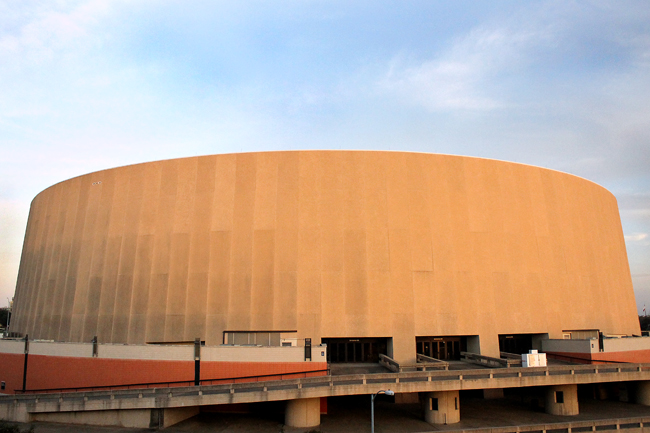The Frank Erwin Center has hosted stars ranging from Kevin Durant to Paul McCartney, but, after serving Austin as a major event hub for the past 37 years, the site’s future residents will tend to patients instead of sinking baskets or belting anthems.
The Erwin Center and the adjacent Denton A. Cooley Pavilion site on Red River Street, located across from the School of Nursing, will be relocated in the next 6-15 years to make room for the new Dell Medical School.
In May of last year, the UT System Board of Regents approved the building plans for the medical school, which will accept its first class in 2016. According to the Medical District Master Plan, a teaching hospital will sit on the lot currently occupied by the Erwin Center. The medical school construction project is projected to cost $334.5 million.
Although the medical school is the reason the Erwin Center will be demolished, the 37-year-old center suffers from the natural deterioration associated with buildings its age, including leaks, according to building manager John Graham. Eleven years ago, the Erwin Center underwent a $55 million renovation to modernize the facility, which included the addition of 28 new suites and an electronic scoreboard.
Aside from issues of old age, the Erwin Center also lacks key attributes that would keep it in line with modern facilities. The lack of surface parking and a single loading dock make it difficult to accommodate modern shows with extravagant sets and multiple 18-weelers worth of material. Erwin Center visitors may also experience heavy traffic because of its proximity to I-35.
These issues factored heavily into the projections for relocation of the Erwin Center made in both the 2013 Campus Master Plan and the subsequent Dell Medical School Master Plan, according to architecture professor Lawrence Speck, who participated in both planning efforts.
“When a building gets to be that old, you have to invest a whole lot of money in upgrading it, or you have to think of replacing it,” Speck said. “Do you spend a whole lot of money — and it will [take] a whole lot of money — to bring it back up to high performance standards? Or do you think that money might be better invested in a new facility?”
The University has not conducted a study to estimate the cost of restoring the Erwin Center to a competitive level for modern events, but Rhonda Weldon, University Operations director of communication, said “millions would not be a surprising figure.” According to Weldon, there is “a rather large ballpark” for potential rehabilitation costs.
Rumors abound concerning potential new locations, but the two most likely candidates at this point appear to be land owned by the University on the east side of I-35 and the Austin American-Statesman’s lot across from Lady Bird Lake, according to multiple reports including an article in the Statesman last week.
Both sites come with their own share of problems. The land the University owns along Manor Road would have many of the same issues the Erwin Center currently experiences because of traffic on the highway’s feeder road.
The Statesman and the Texas Department of Transportation currently occupy the lot on South Congress, and both entities would have to agree to sell the property. The lot does meet many of the school’s requirements for the space: It’s reasonably close to campus, near a vibrant downtown area and adjacent to I-35.
Texas men’s basketball head coach Rick Barnes, whose team plays its home games in the Erwin Center, said he looks forward to a new arena, which he thinks will boost fan attendance. Texas ranked 32nd nationally in home-game attendance in 2013 — averaging 10,495 fans a game, well below the arena’s capacity at 16,755.
“I’m excited for the future of this program when we build a new [arena],” Barnes said. “We know a building this size should have half the size its surface parking. The minimum would be 5,000. We’ve got less than 500.”
Texas head men’s athletic director Steve Patterson declined to comment.
Crowd noise is limited in the arena because of the distance between fans and the court. The fans are far away from the floor at the Erwin Center, which limits the crowd noise in the arena. Many of the loudest venues in college basketball, such as Kansas’ Allen Fieldhouse, have similar seating capacities as the Erwin Center but are smaller facilities, able to trap noise.
Some members of the basketball team say a new arena could be beneficial.
“I’d like the fans to be closer, so they can be more into the game,” sophomore center Prince Ibeh said. “It’s more spaced out in the Erwin Center, and [the lack of noise] makes it tough to get into the game.”
But there are needs other than basketball to consider, according to Matthew Payne, Austin Sports Commission executive director. The Erwin Center has served community purposes for nearly four decades, hosting huge music acts, high school state championships and UT commencement ceremonies.
Payne says the community requires a dynamic multipurpose facility such as the Erwin Center to host large-scale events. Austin has hosted international and national events before, sporting and otherwise, and Payne said he hopes it remains that way.
“I think it needs to be close to downtown,” Payne said. “It truly needs to be a community facility, along with taking care of the needs to the University. The Erwin Center has been a great facility for a long time, so I’m sure they’ll get it right.”





















